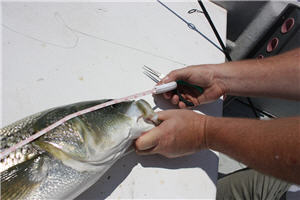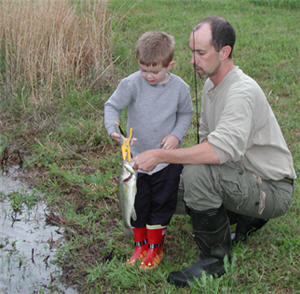
By Tom Keer
The big one is in the boat. It’s met all legal size regulations and is in the net. In a short while you’ll head off the water and be on your way home, and you and your family are already planning on how you’re going to prepare your fresh fish. Here are a few tips for keeping your fish fresh so that it’ll taste great.
- The best way to keep fish fresh is if you have a live well that will accommodate the size of your fish. If you’re fishing from a kayak or a float tube a mesh scuba diver’s bag
 can work just as well. Another option that some anglers use is to keep them on a stringer in the water. In some states, a fish that is put on a stringer is counted as the daily bag (meaning you can’t release the fish on a stringer in the event you catch a bigger fish later in the day). Stringers are a matter of personal preference and I prefer to dispatch the fish.
can work just as well. Another option that some anglers use is to keep them on a stringer in the water. In some states, a fish that is put on a stringer is counted as the daily bag (meaning you can’t release the fish on a stringer in the event you catch a bigger fish later in the day). Stringers are a matter of personal preference and I prefer to dispatch the fish. - Or store your fish is in a cooler full of ice. For short trips crushed ice is ideal. If you’re heading out for the entire day or are going offshore you might consider blocks as they don’t melt as quickly. The first fish of the day should go on the bottom of the cooler and then stack additional fish as you catch ‘em. And if you have a long run add some coarse-grain salt to the cooler. It’ll keep the ice from melting as quickly.
- Bleed your fish. Be sure to bring along a sharp knife. Place the fish’s dorsal fin in your hand. Place the knife edge at the bottom of the gills and slice all the way to the backbone. In doing so you’ll dispatch the fish properly and bleeding it will help to keep it fresh. Already strong tasting fish like mackerel or bluefish taste even stronger if they’re not bled. We’ll bleed other species like tuna, Spanish mackerel, and bonito as well, and it’s a technique that I have carried over to freshwater fish as well. This can be done on the boat before you return to
 the dock.
the dock. - 4. Gut your fish. Some states prohibit the gutting of a fish prior to landing at the dock, so check your regulations before you head out on the water. If you are in a state where this is allowed, here’s how: Place the tip of your knife in the vent and slice along the underside of the belly to the gills. Cut the tab that connects the gills with the backbone. Insert your finger in the gills and pull back down towards the vent.
- 5. Second to the guts, remove the blood and kidney tissue that runs along the fish’s backbone. Use your thumb to separate the two sections and rise when you’re done.
- 6. Note: In some states with length requirements, a fish carcass must be intact when you’re on a boat. That means you can’t filet your fish before you hit the dock (in case rangers want to measure the fish’s length). Be sure to check the regulations so you’re compliant prior to preparing your fish for a great meal.
Tom Keer is an award-winning freelance writer who lives on Cape Cod, Massachusetts.
Visit him at www.tomkeer.com or at www.thekeergroup.com.
- 4313 views


 can work just as well. Another option that some anglers use is to keep them on a stringer in the water. In some states, a fish that is put on a stringer is counted as the daily bag (meaning you can’t release the fish on a stringer in the event you catch a bigger fish later in the day). Stringers are a matter of personal preference and I prefer to dispatch the fish.
can work just as well. Another option that some anglers use is to keep them on a stringer in the water. In some states, a fish that is put on a stringer is counted as the daily bag (meaning you can’t release the fish on a stringer in the event you catch a bigger fish later in the day). Stringers are a matter of personal preference and I prefer to dispatch the fish. the dock.
the dock.